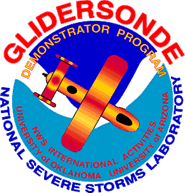Overview

Radiosonde* observations are a vital component of our atmospheric observations system. They provide most of the data used for atmospheric analysis at all levels other than the surface. The data normally includes pressure, temperature, humidity, latitude and longitude. The usual method of employment is to launch the radiosonde attached to a helium balloon, then receive data via radio transmission until the balloon bursts or drifts out of range. Once the balloon bursts, the small (0.3 kg) instrument package falls to Earth. The instrument package is considered expendable, and is not usually recovered because the cost of recovery generally exceeds the cost of the package itself.
While radiosonde packages are considered expendable, the cost is certainly not negligible. With the recent shift from LORAN to GPS navigation technology, the cost for one instrument package has nearly doubled. The goal of the Glidersonde project is to substantially reduce the cost of atmospheric sampling by developing a cost effective method for recovery of the sondes. This would allow better atmospheric sampling at the current cost, and expand the capability of collecting high resolution atmospheric and air chemistry measurements for climate and weather research and operations.
* To learn more about radiosondes, see http://www.meteor.wisc.edu/~hopkins/wx-inst/wxi-raob.htm ![]()
 Glidersonde Demonstration Program
Glidersonde Demonstration Program 